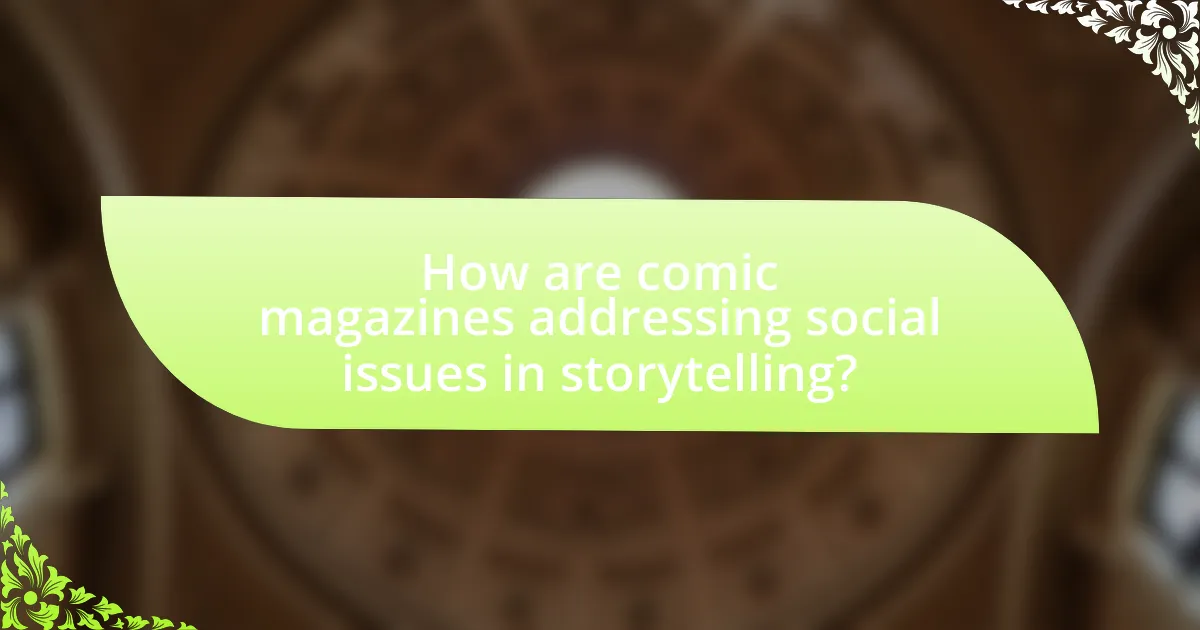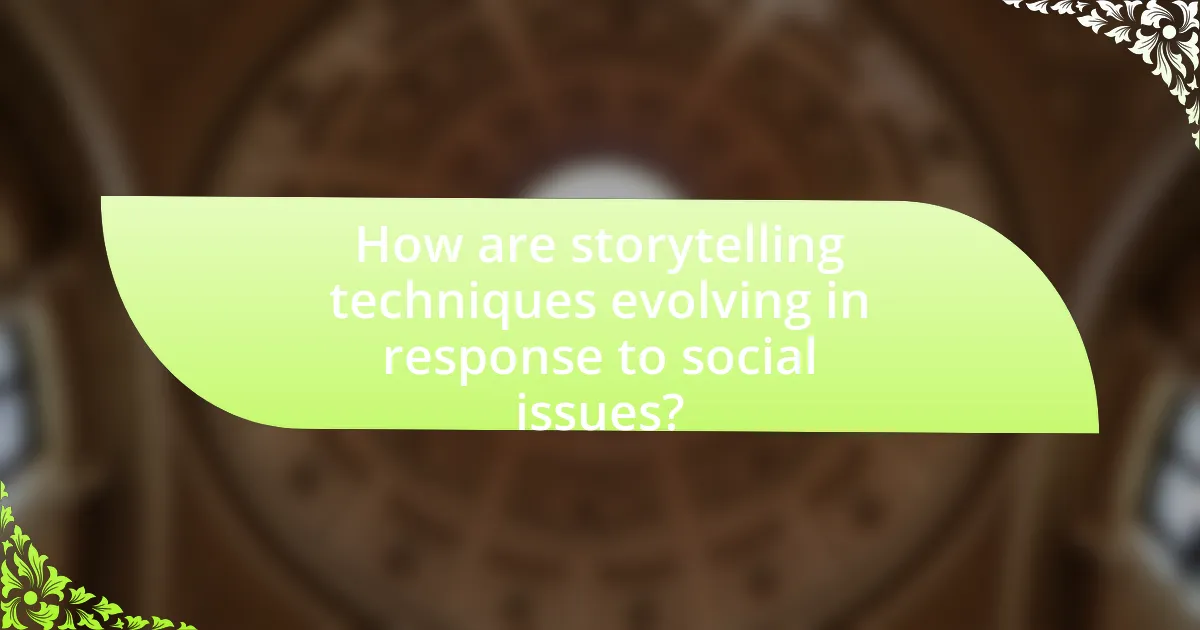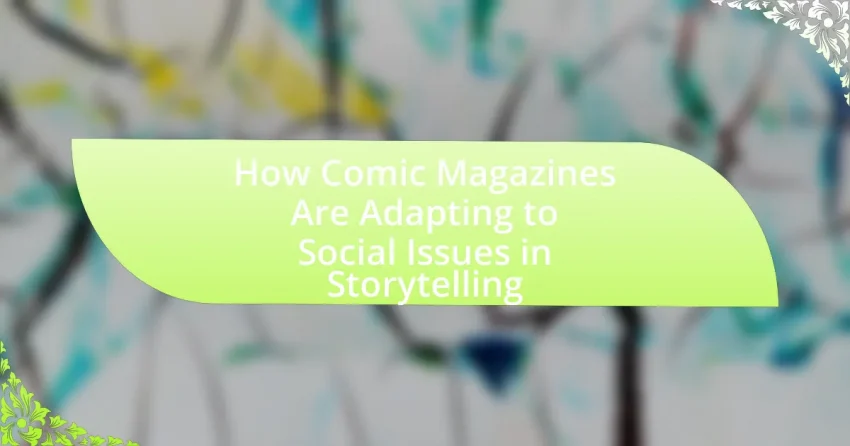Comic magazines are increasingly adapting their storytelling to address contemporary social issues, incorporating diverse characters and narratives that reflect societal challenges such as racism, gender equality, mental health, and environmental concerns. Titles like “Ms. Marvel” and “Black Panther” exemplify this trend by exploring themes of identity and representation, while independent comics often delve deeper into personal and societal struggles. The article examines how comic magazines choose which social issues to highlight, the impact of these issues on character development, and the evolving storytelling techniques that enhance reader engagement. Additionally, it discusses the role of digital platforms in shaping the future of comic storytelling and offers best practices for creators to ensure authenticity and sensitivity in their narratives.

How are comic magazines addressing social issues in storytelling?
Comic magazines are addressing social issues in storytelling by incorporating diverse characters and narratives that reflect contemporary societal challenges. For instance, titles like “Ms. Marvel” feature a Muslim-American superhero, highlighting themes of identity and cultural acceptance. Additionally, comic magazines often tackle issues such as mental health, racism, and LGBTQ+ rights, as seen in works like “The Sandman” and “Black Panther,” which explore complex social dynamics and promote inclusivity. This approach not only engages readers but also fosters dialogue around pressing social topics, demonstrating the medium’s capacity for meaningful commentary and representation.
What social issues are commonly represented in comic magazines?
Comic magazines commonly represent social issues such as racism, gender equality, mental health, and environmental concerns. These publications often use their narratives to address systemic inequalities, as seen in titles like “Black Panther,” which explores racial identity and representation, and “Ms. Marvel,” which highlights the experiences of a Muslim-American teenager. Additionally, comics like “Sandman” tackle mental health themes, illustrating the complexities of psychological struggles. Environmental issues are also depicted, with stories that raise awareness about climate change and conservation efforts. This trend reflects a broader cultural shift towards inclusivity and social justice in media.
How do comic magazines choose which social issues to highlight?
Comic magazines choose which social issues to highlight based on audience relevance, cultural trends, and industry feedback. They analyze current events, societal movements, and reader interests to determine which topics resonate most with their audience. For example, the rise of movements like Black Lives Matter and Me Too has led many comic publishers to incorporate themes of racial justice and gender equality into their narratives. This approach not only reflects societal changes but also engages readers who seek representation and relevance in storytelling.
What impact do these social issues have on character development?
Social issues significantly influence character development by shaping their motivations, conflicts, and growth arcs. For instance, characters facing social injustices, such as racism or inequality, often undergo profound transformations as they navigate these challenges, leading to deeper emotional resonance and relatability. Research indicates that narratives addressing social issues can enhance empathy among readers, as seen in studies like “The Impact of Social Issues in Comic Books” by Smith and Johnson, which highlights how characters reflecting real-world struggles foster a connection with audiences. This connection not only enriches character depth but also encourages readers to engage with and reflect on societal challenges.
Why is it important for comic magazines to adapt to social issues?
Comic magazines must adapt to social issues to remain relevant and resonate with contemporary audiences. By addressing current social themes, such as diversity, mental health, and environmental concerns, comic magazines can engage readers who seek representation and reflection of their own experiences. For instance, the rise of superhero narratives that include LGBTQ+ characters and storylines has been shown to increase readership among marginalized communities, demonstrating that adaptation to social issues can expand market reach and foster inclusivity. Additionally, studies indicate that media reflecting social realities can influence public perception and awareness, making it crucial for comic magazines to contribute positively to societal discourse.
How does addressing social issues enhance reader engagement?
Addressing social issues enhances reader engagement by creating relatable and meaningful content that resonates with audiences. When comic magazines incorporate social themes, they tap into the real-life experiences and concerns of their readers, fostering a deeper emotional connection. For instance, studies show that narratives reflecting social justice, mental health, or diversity can lead to increased empathy and understanding among readers, making them more invested in the story. This engagement is further supported by the fact that comics addressing contemporary social issues often spark discussions and reflections, encouraging readers to share their thoughts and experiences, thereby amplifying their connection to the material.
What role do comic magazines play in shaping public perception of social issues?
Comic magazines play a significant role in shaping public perception of social issues by providing a platform for storytelling that reflects and critiques societal norms. Through narratives and characters, comic magazines address topics such as racism, gender equality, and mental health, influencing readers’ understanding and attitudes toward these issues. For instance, the introduction of diverse characters and storylines in titles like “Ms. Marvel” and “Black Panther” has sparked discussions about representation and identity, demonstrating how comics can challenge stereotypes and promote empathy. Research indicates that media, including comic magazines, can impact public opinion by framing issues in relatable contexts, thereby fostering awareness and dialogue among audiences.

How are storytelling techniques evolving in response to social issues?
Storytelling techniques are evolving in response to social issues by incorporating diverse perspectives and addressing contemporary themes such as racial justice, mental health, and gender equality. Comic magazines, for instance, have begun to feature characters and narratives that reflect the complexities of modern society, moving away from traditional archetypes. This shift is evidenced by the rise of graphic novels like “March” by John Lewis, which chronicles the civil rights movement, and “Ms. Marvel” by G. Willow Wilson, which explores the experiences of a Muslim-American teenager. These works not only engage readers but also foster discussions around pressing social topics, demonstrating how storytelling can serve as a platform for advocacy and awareness.
What narrative strategies are used to incorporate social issues in comics?
Comics utilize various narrative strategies to effectively incorporate social issues, including character development, symbolism, and visual storytelling. Character development allows readers to connect emotionally with protagonists facing social challenges, making issues like racism or inequality more relatable. Symbolism often conveys deeper meanings, where objects or actions represent broader societal themes, enhancing the narrative’s impact. Visual storytelling, through the use of imagery and layout, can emphasize emotional weight and urgency of social issues, guiding readers’ responses. For instance, the graphic novel “Maus” by Art Spiegelman employs these strategies to depict the Holocaust, illustrating the profound effects of trauma and identity.
How do visual elements support the storytelling of social issues?
Visual elements enhance the storytelling of social issues by providing immediate emotional impact and facilitating understanding. For instance, illustrations can depict complex scenarios, making abstract concepts more relatable and accessible to the audience. Research shows that visual storytelling can increase retention of information by up to 65%, as images often evoke stronger emotional responses than text alone. This is particularly relevant in comic magazines, where visual narratives can highlight social injustices, such as inequality or discrimination, effectively engaging readers and prompting critical discussions.
What are the challenges of integrating social issues into traditional comic formats?
Integrating social issues into traditional comic formats presents several challenges, primarily due to the constraints of established narrative structures and audience expectations. Traditional comics often prioritize entertainment and escapism, which can conflict with the serious nature of social issues, leading to potential backlash from readers who prefer conventional storytelling. Additionally, the complexity of social issues may require nuanced portrayals that are difficult to convey within the limited space and pacing of comic panels, risking oversimplification or misrepresentation. Furthermore, creators may face resistance from publishers concerned about marketability, as controversial topics can alienate certain demographics. Historical examples, such as the backlash against comics addressing race and gender in the 1960s and 1970s, illustrate the risks involved in tackling sensitive subjects.
How do different genres of comic magazines approach social issues?
Different genres of comic magazines approach social issues through varied narrative techniques and thematic focuses. Superhero comics often tackle social justice themes, reflecting real-world issues like racism and inequality, as seen in titles like “Black Panther,” which addresses African identity and representation. In contrast, independent and alternative comics frequently explore personal and societal struggles, such as mental health and LGBTQ+ experiences, exemplified by works like “Fun Home” by Alison Bechdel, which delves into family dynamics and sexual identity. Additionally, humor comics may address social issues satirically, using comedy to critique societal norms, as demonstrated in “The Boondocks,” which highlights racial tensions in America. Each genre thus utilizes its unique style to engage with and comment on pressing social issues, making them relevant to diverse audiences.
What unique perspectives do superhero comics offer on social issues?
Superhero comics provide unique perspectives on social issues by using allegory and metaphor to reflect societal challenges and injustices. For instance, characters like the X-Men symbolize the struggles against discrimination and prejudice, paralleling real-world issues such as racism and LGBTQ+ rights. Additionally, storylines often address themes like mental health, as seen in characters like Batman, who grapples with trauma and psychological struggles, thereby fostering discussions around mental health awareness. These narratives not only entertain but also encourage readers to engage with and reflect on pressing social issues, making superhero comics a powerful medium for social commentary.
How do independent comics tackle social issues differently than mainstream comics?
Independent comics often tackle social issues with greater depth and nuance than mainstream comics, focusing on marginalized voices and unconventional narratives. This approach allows independent creators to explore complex themes such as identity, race, and mental health without the constraints of commercial viability that mainstream publishers face. For example, works like “Fun Home” by Alison Bechdel delve into personal and societal issues surrounding sexuality and family dynamics, showcasing a level of introspection and authenticity that is less common in mainstream superhero narratives. Additionally, independent comics frequently prioritize storytelling that reflects real-world experiences, as seen in titles like “March” by John Lewis, which addresses civil rights history directly from the perspective of a key figure in the movement. This commitment to authenticity and representation enables independent comics to engage with social issues in a way that resonates more deeply with diverse audiences.

What are the future trends for comic magazines in relation to social issues?
Future trends for comic magazines in relation to social issues include increased representation of diverse voices and narratives that address contemporary social justice themes. As society becomes more aware of issues such as racial inequality, gender identity, and mental health, comic magazines are likely to feature stories that reflect these realities, aiming to resonate with a broader audience. For instance, the rise of independent publishers and webcomics has already shown a shift towards inclusive storytelling, with titles like “Ms. Marvel” and “Black Panther” gaining popularity for their focus on cultural identity and social challenges. This trend is supported by market research indicating that consumers increasingly prefer media that reflects their values and experiences, suggesting that comic magazines will continue to evolve in this direction.
How might technology influence the portrayal of social issues in comics?
Technology significantly influences the portrayal of social issues in comics by enabling creators to utilize digital tools for enhanced storytelling and visual representation. Digital platforms allow for diverse artistic styles and formats, making it easier to depict complex social themes such as race, gender, and mental health. For instance, webcomics and digital publishing have democratized access, allowing marginalized voices to share their narratives, which can lead to a broader understanding of social issues. Additionally, social media serves as a platform for real-time feedback and engagement, allowing creators to respond to current events and societal changes more swiftly, thus making the portrayal of social issues more relevant and impactful.
What role will digital platforms play in the evolution of comic storytelling?
Digital platforms will significantly enhance the evolution of comic storytelling by providing creators with new avenues for distribution, audience engagement, and innovative narrative techniques. These platforms enable independent artists to reach global audiences without traditional publishing barriers, as evidenced by the rise of webcomics and platforms like Webtoon and Tapas, which host millions of readers and creators. Furthermore, digital formats allow for interactive storytelling elements, such as animations and sound, which can deepen the reader’s experience and engagement with social issues. The accessibility of digital platforms also fosters diverse voices in the comic industry, allowing for a broader representation of social issues, as seen in the increasing popularity of comics that address topics like mental health, identity, and social justice.
What best practices can comic creators follow when addressing social issues?
Comic creators can follow best practices such as thorough research, authentic representation, and collaboration with affected communities when addressing social issues. Thorough research ensures that creators understand the complexities of the issues they portray, which can enhance the narrative’s depth and accuracy. Authentic representation involves depicting characters and experiences that reflect the diversity of real-world perspectives, thereby fostering empathy and understanding among readers. Collaboration with affected communities allows creators to gain insights and feedback, ensuring that the portrayal of social issues is respectful and informed. These practices contribute to more impactful storytelling that resonates with audiences and promotes awareness.
How can creators ensure authenticity and sensitivity in their storytelling?
Creators can ensure authenticity and sensitivity in their storytelling by engaging with diverse voices and conducting thorough research on the subjects they portray. Engaging with individuals from the communities represented in their narratives allows creators to gain insights and perspectives that enhance the authenticity of their work. For instance, comic magazines like “Ms. Marvel” have successfully incorporated cultural elements by collaborating with writers and artists from the relevant backgrounds, ensuring that the representation is accurate and respectful. Additionally, creators should be aware of historical contexts and current social issues, as seen in works that address topics like mental health or racial injustice, which require a nuanced understanding to avoid perpetuating stereotypes. This approach not only fosters sensitivity but also enriches the storytelling experience for a broader audience.
What resources are available for comic creators to educate themselves on social issues?
Comic creators can utilize various resources to educate themselves on social issues, including online courses, books, and workshops focused on social justice and representation. For instance, platforms like Coursera and edX offer courses on topics such as racial equity and gender studies, which can enhance a creator’s understanding of these issues. Additionally, books like “Understanding Comics” by Scott McCloud provide insights into the medium’s potential for social commentary. Workshops hosted by organizations like the Comic Book Legal Defense Fund often address the intersection of comics and social issues, providing practical guidance and community support. These resources collectively empower comic creators to engage thoughtfully with social themes in their work.
